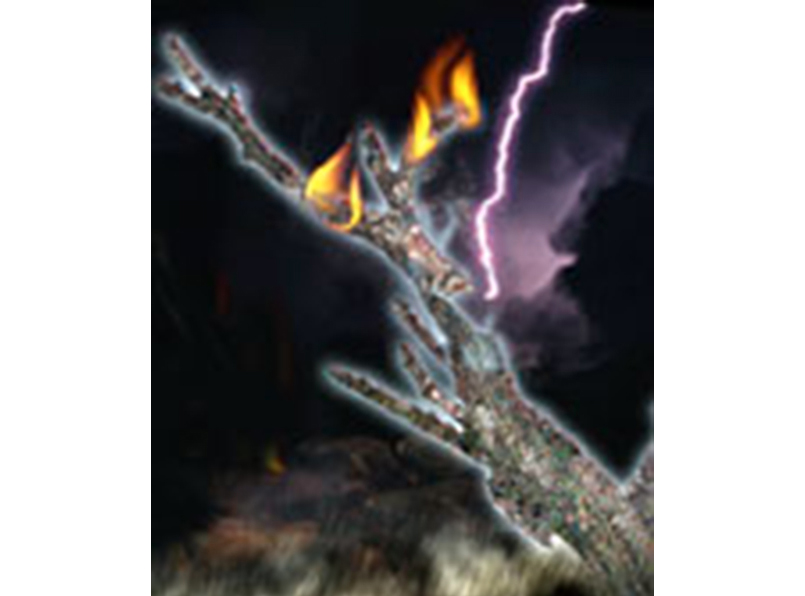
1st time:
Lightning & Fire.

2nd time:
Pre-human discovering fire.
The Phosphene, the foremost among the Phenes, holds a profound connection to the genesis of mankind.
In the earliest epochs, humanity’s journey was illuminated by the flickering flames of fire—a focus that transcended through the annals of time.
Initially, the primitive ancestors awaited the serendipitous strike of lightning upon a tree to ignite the flames. Thus, they seized the essence of fire. However, lacking the knowledge to create it, they took turns in vigilance over this sacred element. Even during their nomadic wanderings, a member of the clan bore the solemn responsibility of safeguarding this vital flame.
From the primordial depths of human existence, light emerged.
The inaugural observers beheld a phenomenon utterly unforeseen yet transformative for the savage man and communal life itself. The activities of the earliest societies revolved around the sacred fire, shaping their hierarchies and rituals. The custodians of the flame held such paramount importance that failure to maintain it was met with the severest penalty—death. Simultaneously, they were revered for possessing knowledge beyond comprehension. Thus, from this crucible of fire and reverence, shamanism arose as humanity’s primal religion.
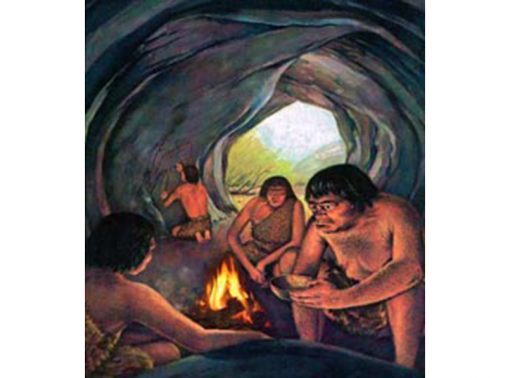
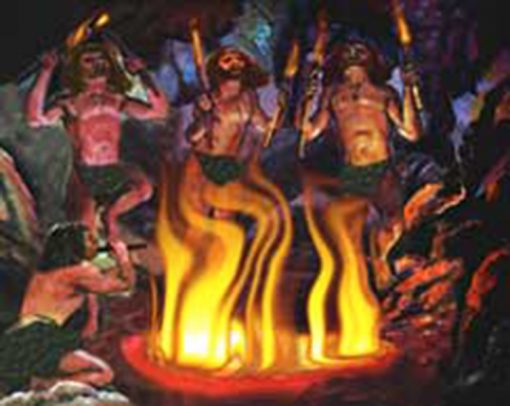
3rd time:
Sacred dances & rhythmed sways.
For millennia, the practice of swaying has been integral to various traditions, religious rituals, and initiatic groups, serving as a catalyst for psychic experiences.
The innate inclination of children to sway, coupled with the instinctual act of mothers rocking their infants, underscores the physiological necessity and rhythmic function of swaying, often overlooked by adults. Unfortunately, many parents discourage swaying in children without realizing its profound significance, as adults often lose touch with their innate rhythms and must exert considerable effort to rediscover them.
To harness the full potential of swaying in adults, a primary condition, alongside phosphene observation, is required: rhythmic thinking. When thoughts are organized rhythmically, they gain tremendous energy, amplifying cerebral rhythms and enhancing cognitive processes.
The power of rhythmic thinking is evident in various religious practices such as prayers, litanies, hymns, and mantras, which stimulate brain regions associated with religious cognition and expanded consciousness. Historically, rhythmic learning methods, such as singing multiplication tables, were prevalent in education systems, facilitating easier memorization and enhancing intellectual capabilities.
However, contemporary education systems have largely abandoned rhythmic learning in favor of analytical approaches, relegating the utilization of rhythms to television advertisements, where catchy slogans are easily memorized by children.
Nevertheless, certain cultures and religious communities still prioritize rhythmic learning, maintaining their intellectual superiority. The phosphene serves as a crucial scientific tool, offering insights into the cyclical nature of human evolution and providing the “missing link” for scientists seeking to understand the transition from pre-hominids to modern humans, along with the accompanying modifications and mutations. Dr. Lefebure’s pioneering work has illuminated this essential aspect of human development, offering valuable insights into our evolutionary journey.
Phosphenism serves as the foundational principle underlying every religion and initiatic tradition, serving as the connection between them. Dr. Lefebure’s groundbreaking work allows us to grasp that the worship of celestial bodies like fire, the moon, the sun, and the stars is not merely symbolic but rooted in the act of thinking while gazing at sources of light.
Phosphenes, known by different names across cultures, have been universally utilized, underscoring the significance of fire worship, as well as solar, lunar, and stellar reverence. They form the bedrock of civilizations practicing solar worship, including the Mayan, Egyptian, Aryan, Zoroastrian, Celtic, Roman, Greek, Chinese, Japanese, and Polynesian cultures.
Even today, solar worship persists in religions like Shintoism. Shamanism, the cornerstone of many religions, is fundamentally based on the power of fire, echoing the ancient belief that “Man became Man when he domesticated fire.”
Phosphenic phenomena have historically facilitated expanded consciousness and universality. Figures like Akhenaton and Emperor Julian sought to restore solar worship, recognizing its profound implications. Akhenaton drew inspiration from the religion of Heliopolis, focusing on the sun while praying, as detailed in “Phosphenic Mixing Applied to Education.” Emperor Julian, an initiate of the Mysteries, emphasized the invincible sun in his spiritual pursuits.
Initiation ceremonies in the Eleusinian Mysteries involved focusing on a torch (creating a phosphene), visualizing an ear of wheat (principle of Phosphenic Mixing), demonstrating the deep-rooted connection between rituals and phosphene-induced consciousness expansion.
Throughout history, prayers in various religions have been made while focusing on a lighted candle, highlighting the centrality of light in religious practices. This historical context underscores the importance of rhythmic thinking while focusing on light sources, serving as the foundation of religious worship across cultures.
By understanding this historical reality through the lens of cerebral physiology rather than symbolism, we gain insight into the principles of Phosphenism, unlocking hidden truths about human consciousness and spiritual evolution.
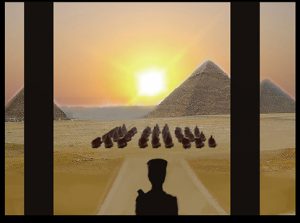
AN ANCIENT TECHNIQUE
Phosphenes are not merely a modern discovery; they have been utilized in ancient techniques across cultures and traditions. Producing a phosphene is as simple as focusing on a source of light, whether it be fire for the Zoroastrians, stars for the Tibetans, or the reflection of the moon on a silver mirror for Nostradamus.
Pygmy witch doctors, for example, still rely on fire flames to induce visions that guide hunters to game. Remarkably, ethnologists sitting alongside these sorcerers have reported experiencing the same visions simultaneously, illustrating the shared nature of phosphene-induced experiences.
Nostradamus famously used a silver mirror reflecting the moonlight to trigger clairvoyant phenomena, harnessing the power of phosphene creation. Similarly, fortune tellers often place candles in front of crystal balls to create phosphene reflections, facilitating their visions.
Phosphenes possess several surprising properties:
- Amplification of Thoughts: Phosphenes amplify thoughts, a principle explored in “Phosphenic Mixing Applied to Education.”
- Telepathic Transmission: They are easily transmitted via telepathy, as detailed in “The Key to Supernatural Phenomena.”
- Information-rich: Under specific conditions, they can provide more information than an electroencephalogram. They can be photographed, revealing objects passing through them even in darkness or when covered by blindfolds, as discussed in “The Oscillation of the Brain by the Oscillation of Double Phosphenes.”
These properties underscore the multifaceted nature of phosphenes and their significance in various domains, from spirituality to scientific exploration.
“Living beings tend to exteriorize their view of the world.”
Charles DARWIN
“Think by observing a phosphene and you will become a radiant being, a sun in society.”
Francis LEFEBURE
“Just like the chameleon, the human being is a reflection of his environment. However, thanks to Phosphenism you can protect yourself from any form of mimetism.”
Daniel STIENNON
The “FEELING OF OBVIOUSNESS”
The mystery surrounding the lack of historical documentation regarding the phenomenon of phosphenes is indeed perplexing. Throughout human history, individuals have expressed their understanding of the world through various forms of artistic expression, yet there is a noticeable absence of explicit references to phosphenes in these records.
Dr. Lefebure addresses this enigma in his book “The Pneumophene,” shedding light on the underlying reasons for this oversight. However, despite his insights, scientists are left pondering another question: What potential lies in the development of the human brain after several generations of practicing Phosphenic Mixing?
This question opens up a realm of possibilities for scientific exploration and speculation. To delve deeper into this intriguing topic, readers are encouraged to explore “Phosphenic Energy Universe,” our magazine available for purchase on this website.
PHOSPHENIC DISCOVERY
Dr. Lefebure’s theory does not seek to challenge the accepted theories of evolution today. Instead, it offers a new avenue of research previously unknown to scientists before his publications.
His groundbreaking work has been shared with various scientific and medical institutions in France, marking him as a pioneer in his field. As early as 1960, Dr. Lefebure had informed French authorities across educational, medical, scientific, industrial, religious, and political domains about his numerous discoveries and their wide-ranging applications.
Today, Dr. Lefebure’s research on the applications of cerebral rhythms, particularly cerebral alternation and the rhythmic functions of the brain, stands as a solid reference point for researchers in various disciplines.

Dr. Lefebure’s work on the “Genesis of Humanity” has been recognized and endorsed by the French National Committee, aligning with the theme of the “International Year of Light and Technologies Using Light” proclaimed by the United Nations in 2015. This international initiative, led by a consortium of scientific institutions and UNESCO, aims to highlight the importance of light in education, technology, and science.
International Year of Light 2015
The book “Sacred Pathways: The Brain’s Role in Religious and Mystic Experiences” by Todd Murphy represents a belated acknowledgment of Dr. Lefebure’s pioneering work on cervoscopy, alternophony, and other related phenomena. Published by the University of Toronto in the late 1980s, this book delves into the intricate relationship between the brain and mystical or religious experiences, echoing the insights and discoveries made by Dr. Lefebure decades earlier.
Through his research, Dr. Lefebure provided groundbreaking insights into the neurological mechanisms underlying religious and mystical experiences, shedding light on phenomena such as altered states of consciousness and telepathy. While Dr. Lefebure’s work may have been overlooked or misunderstood in its time, contemporary publications like “Sacred Pathways” serve to validate and amplify his contributions to the field of neuroscience and religious studies.
By recognizing the role of the brain in shaping religious and mystical experiences, “Sacred Pathways” and similar works contribute to a deeper understanding of human consciousness and spirituality. They also underscore the enduring relevance and significance of Dr. Lefebure’s research in advancing our knowledge of the brain’s capabilities and its profound impact on human behavior and belief systems.
The work on Cervoscopy, which predates that of Todd Murphy, did not benefit from a preface by the Dalai Lama or by a neuroscientist.
These famous people have not discovered anything extraordinary, they are even late on this point, as you can verify by a simple search of the first editions of the works on Phosphenism, and of the reports made to the CNRS as early as 1960.
The fact that phosphene is a photonic field with emission and re-emission of photons and biophotons is a common experience for a practitioner of Phosphenism.
You can now find scientific literature on the creation of phosphenes and entoptic images by photons and biophotons (cf. Bokkon researchs, Negative afterimages by long-term ultraweak re-emission of visible photons; Delayed luminescence; Phosphene phenomenon: a new concept. Delayed luminescence, Near death experiences: a multidisciplinary hypothesis, etc.). You just have to go to the website of M. Bokkon, a neuroscience researcher.
This aspect of re-emission of photons and biophotons has been revealed by Dr. Lefebure. This explains the possibility of photographing phosphene on a sensitive plate and allows us to understand its caloric properties.
Dr. Bookon is doing fundamental research on phosphenes and biophotons. You will not find in the current scientific literature any revelation on the caloric, photo-reportable properties of phosphene.
But we have no doubt that this will come as a result of Mr. Bokkon’s surprise about the various uses of phosphenes in Phosphenism. We wish him future applications and reflections in the interest of all and to find financers for his innovative work, as this is not possible for us. His research only confirms the origin of phosphene and its particularities.
The re-emission by the eye of photons and biophotons from the photonic field that is phosphene explains why it is photographed and endowed with caloric properties. As a luminous phenomenon, thus formed of electrons, a form of transmissibility of phosphene could be explained. Another fundamental property is the vision in darkness of certain forms while the eyes are closed under an opaque blindfold (physical phosphovision).
No neuroscientist has, to date, assumed such properties to phosphenes, due to ignorance of the use of co and post-phosphenes, nor has he considered phosphenes as a means of examining brain function. The vision of shapes through an opaque band in the presence of post-phosphene (phosphovision) opens possibilities of studies to restore sight to blind people by stimulating photons and biophotons through the optic nerve.
The discovery of physiological phosphene, its use and its rhythms that provoke synchronization or alternation between the brain and neurons, allows us to understand the laws on the development of the nervous system and the frontal cortex.
Phosphene reveals the optimal rhythms of the development of the nervous system and the brain, it is an expression of the most archaic language of the latter. (see H. Umit Sayin’s work, Professor at the University of Istanbul: “Does the Nervous System Have an Intrinsic Archaic Language? Entoptic Images and Phosphenes.”).
We have understood that this development of the nervous system and the brain is expressed in baby and child swings; rhythmic rhymes; traditional African storytelling methods; etc. Traditional narrative structures reveal these cerebral rhythms as Marcel Jousse will develop in his rhythmo-pedagogy or anthropology of gesture. Rhythms through synchronization and cerebral and neuronal alternation promote learning.
But we have discovered that children’s games using swings or gyrations are only the most favorable expression of the development of the nervous system and the brain. The initiatic exercises of many brotherhoods are only the development of these children’s games. E.g.: swaying of the body during learning, rotation of the dervishes (function of the gyrophene).
These various exercises, which are based on explanations in cerebral neurophysiology, make it possible to obtain modified states of consciousness. This in a much simpler way than Michael Persinger’s various devices.
Phosphenes and rhythms, modified states of consciousness and information theory.
Certain experiences during altered states of consciousness such as lucid dreaming or extensions of consciousness open up another field of exploration in terms of creativity and the emergence of ideas through contact with fields of information that structure human knowledge.
This is in line with the discoveries of Pr. Paul Chauchard, which will be taken up in Pr. Régis Dutheil’s book, “The Superluminous Man.” This opens access to the possibilities of innate knowledge through an informational transfer during lucid dream states or extension of consciousness. A direct plunge into our psyche to see how dreams are created and de-created, etc. Obviously, this undermines the psychological theories of interpretation of dream symbolism.
We could take a step forward in the development of our knowledge by making permanently accessible or facilitating access to these fields of information, which have sometimes given scientists the solution to their problems, hence the famous French proverb “The night gives advice”.
In the same way, practitioners of Phosphenism who had no knowledge of music perceived the hearing of incredibly complex music, as Mozart used to say, and then recomposed it from memory. And this is only a small example of the experiences they had.
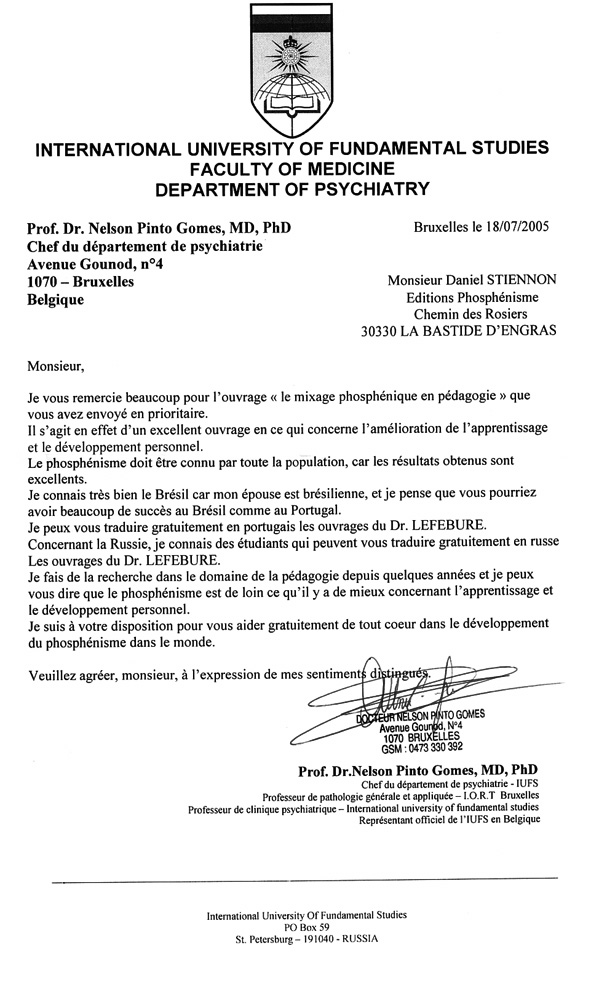
Letter’s translation:
Sir,
Thank you very much for the book “The Phosphenic Mixing applied to Education” that you sent as a priority.
It is indeed an excellent work in terms of improving learning and personal development.
Phosphenic mixing should be known by the whole population, because the results obtained are excellent.
I know Brazil very well because my wife is Brazilian, and I think you could have a lot of success in Brazil as well as in Portugal.
I can translate Dr. LEFEBURE’s books into Portuguese for free.
Regarding Russia, I know students who can translate Dr. LEFEBURE’s books into Russian for free.
I have been doing research in the field of pedagogy for a few years now and I can tell you that Phosphenism is by far the best in terms of learning and personal development.
I am at your disposal to help you wholeheartedly and free of charge in the development of Phosphenism in the world.
Yours sincerely.
